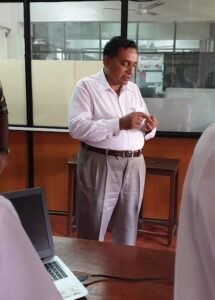I graduated in 1983 and in 1984 became an Asst. Lecturer (probationary). At that time the existing research link was established by Prof. M. L. T. Kannagara in the latter part of the 1970s with Uppsala University, Sweden has almost reached to an end due to the non-returning of PhD students sent to Sweden on Sandwich type programmes. At that time I decided to offer myself to get a locally awarded PhD in view of strengthening such capabilities in Sri Lanka. I joined the Atmospheric Research Group in 1986 and got registered for a local Mphil/PhD degree programme(and the breakthrough was not so easy as there were no solid rules on local sandwich-type PhDs at that time and I were to suffer a lot from bureaucratic problems till I received the PhD as the forerunner of local PhD programmes in Physics in Sri Lanka). I gradually started to develop the Atmospheric research laboratory from nothing, i.e no equipment at all at the beginning. At that time my local supervisor Prof O. W. Jayaratne was the only group member. My Swedish supervisor Prof Sven Isralesson and his research scientist Eng Edgar Knudseon visited Sri Lanka at a time many foreigners were reluctant to visit Sri Lanka due to terrorist propaganda. By the late 80s I was able to invite Prof Vernon Cooray of the Institute of High Voltage Research to Sri Lanka.. By 1990 the Atmospheric and Lightning research lab was built to the regional standards due to my sole efforts.
In 1992 I defended my PhD thesis “On Fair Weather and Thunderstorm Electricity – basis for Construction of an Atmospheric Electrical Station in Sri Lanka” – University of Colombo, Sri Lanka; 1992”.
(This was the 1st ever local PhD in Physics awarded by the Colombo University. The PhD work was performed both in Uppsala University (Institute of High Voltage Research + Dept. of Meteorology), Sweden and Colombo University, Sri Lanka, under a collaborative research link programme between the universities of Colombo, Sri Lanka and the Uppsala University, Sweden).
Up to the year 1998, I was the group leader of the Atmospheric Physics and Lightning research group. I had two challenges to meet a) Development of the research laboratory from the scratch to regional training standards & b) Recruiting new permanent members to the group.
By 1993-94, I was working alone in the group (with some research assistants) as Prof O.W Jayaratne too got retired. (The page 10 of 1994 travel report issued by Prof. Lennart Hasselgrenthe Director/International Programme in the Physical Sciences(IPPS)written after his visit to Sri Lanka-. Extracts from the report are: “2.1.4 Atmosphere Physics/Lightning Research Group: Also for this group, the progress has been slower than expected but improved tremendously during the last years. IPPS started the support to this group in 1977/78 and out of total 6 people so far trained through IPPS, there are only one left(viz. Dr Chandana Jayaratne) in the group and one that has retired (Viz. Prof O W Jayaratne) …”
Soon after my PhD I was able to recruit three 1st class Physics special degree students (R Lelewala, IMK Fernando and G A C Gomes) and convince them to register for a local PhD degree programme and to do research under the collaborative research link between the universities of Uppsala, Sweden and Colombo, Sri Lanka(while all of them were having the good opportunities to go to USA for their PhDs they agreed to join and today all of them were serving the Department of Physics as Senior Lecturers. During my tenure of group leadership, millions worth grants were received from the IPPS, Sweden (both for personnel development and equipment) was taken. The amount received up to 1993 was Swedish Kronor 2102873 (more than Rs 20 million) (please read one of my annual reports(1998) written to IPPS- Sweden)
Amount of time that I spent on procurement of equipment, preparation of project reports and grants requests, strengthening international collaborations, providing local hospitality to visiting foreign scientists under the collaborative research link programme, supervising the PhD students and look into the related beurocratic work, conducting research work day-and-night in the case of lightning, for nearly a period of 15 years has paved the way for future generation in this country to conduct research in lightning and atmospheric physics and to obtain PhDs locally in this filed (particularly at a time when everyone was scared to get a local PhD degree). Today the atmospheric and lightning research group is functioning with sufficient manpower and advance lab equipment, serving locally as well as regionally with special attention to lighting physics and lightning protection. Acquiring the local capability of awarding MPhils and PhDs degrees too has given a tremendous boost to the development of research capabilities within the university and in the country.
